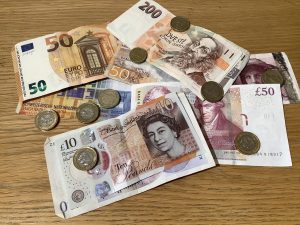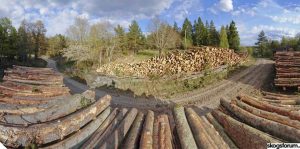We have touched the theme of timber prices during the last few weeks here at NordicWoodJournal.com. We have also pointed out the importance of knowing your forest to achieve a good position in negotiations with wood buyers when you plan to do some felling. In such negotiations, it is of utmost importance to know what a good price is.
Photo: Per Jonsson
How do you know what price is right?
The average Swedish forest owner don´t do business every year. In some cases, several years can pass between the timber deals, especially for a small forest owner. Considering that the most common advisers are employed by the industry as timber buyers, it can be difficult for a single forest owner to find out what the right value of his or her forest is.
I many countries, like Norway and Finland, timber price statistics are presented monthly. For a forest owner who wants so sell timber it´s easy to see what the prices are for the moment, and how they have developed lately.
Sweden stands out
In Sweden, a country with one of the World’s most modern and digitalized forest management systems, price statistics are almost impossible to find. When you do find it, it’s normally old figures. As for the annual felling, we have the same problem. The figures for 2021 are based in prognoses, and those for 2020 are still (24thJanuary 2022) preliminary.
The Swedish Forest Agency are responsible for statistics concerning Swedish forestry. They shall report data on three areas:
– Production
– Employment
– Environmental and social issues
The concept Production includes statistics about annual felling and prices according to the Forest Agency. It should be mentioned that the Swedish University of Agricultural Sciences, SLU, contributes with some statistics as well. They are responsible for statistics on “Condition and changes of the Swedish forests”.
The sister-site iSkogen.se has been in contact with several persons at the Swedish Forest Agency, who are responsible for the statistics. A summary of those contacts shows dissatisfaction and despair over how difficult it is to get the necessary data to produce the statistics from the forest industry. And this even though all timber measurement is made by one organization in Sweden: Biometria.
Centralized measuring
As the timber measurement is centralized in Sweden, and all timber volumes are registered by Biometria, this shouldn´t be too difficult. Still, it seems impossible, even for the Forest Agency, to get the required information to present the above-mentioned statistics. How come?
A quick look at Biometria’s list of members tells us that a vast majority of them are forest industries. The forest owners’ associations are members as well, but bear in mind that they too own both pulp- and sawmills. So, which chair are they sitting on here?
It becomes even more interesting when we look at the management of Biometria and find that the managing director Ms. Ingela Ekebro also is a Senior advisor at SCA, one of Sweden’s largest forest industries. There is, of course a possibility that SCA haven´t had time to update the homepage. But even if that´s the case, the connection between Biometria and the industry is obvious.
Why is this data important?
On a healthy market, prices must be official and comparable. We all like to compare prices when we buy something, but also when we sell something. For the above-mentioned forest owner, who makes a timber deal maybe once every five or ten years, this kind of data is very important.
It seems that the Swedish forest industry wants to limit the access of information about volumes and prices of timber to keep the prices down. When looking at timber prices in the neighbor country Finland, it seems to be the case. The timber prices in Finland, and most of the other forestry countries in Europe, are much higher than in Sweden. One might say that the Swedish industry’s strategy has been successful. But does it belong in a democratic market economy?
In the long run, a transparent access to price statistics would contribute to a better distribution of the profit from the end products. It should also contribute to an optimized usage of the raw material from the forest, and as base for decisions about new investments in forest industry to increase the share of value-added products such as engineered wood.
Photo: Skogsforum.se
Felling volume – an increasingly important value
Another aspect of having open data in forestry is that carbon balance and storage is becoming more important today. Felling volume, is one key parameter in this balance, and growth is the other.
As mentioned above, the Swedish felling volumes are presented with a long delay. Still in January 2022 the figures for 2020 are preliminary. The figures for 2021 are based on earlier prognoses. If there was a will, this data could easily be taken from the Biometria data bases directly, as it´s being done in Norway. The accuracy in the quick delivered Norwegian figures is no worse than in the Swedish figures when they finally are published.
The Swedish Forest Agency takes action
The Forest Agency has, together with 27 other authorities tied to statistics, made a request to the Swedish Government to modernize the regulations about official statistics. The Forest Agency wishes to clarify their responsibility for statistics to be able to put more pressure on Biometria to hand out the needed information.
The plan is that the new regulations shall be activated on 1st July this year, which should make it possible for the Agency to get data from the forest industries, and Biometria’s data bases, much earlier. So, hopefully we will have up to date timber statistics already this year?
How do you know what price is right?
The question still stands. How do you know what to charge for your timber in Sweden? A classic way of finding that out is to talk to neighbors and friends. “What did you get …?” The problem is that the neighbor most likely has the same problem as you. The adviser/timber buyer decides the price.
Again, we see the importance of knowing what you have in your forest. If you know your forest you can argue with the buyer and say: “This stand incudes very good quality saw logs and is worth more than what you offer.” In such a case you can also remind the buyer that there are other buyers on the market that might be more flexible. Today, this is probably the best you could do, except for waiting until fresh statistics are available – To sell to the highest bidder.
One option could be not to sell until the prices go up. But for that to be efficient it takes that more forest owners than you act like that. On the day when the industry finds it difficult to get timber, the prices will go up.













